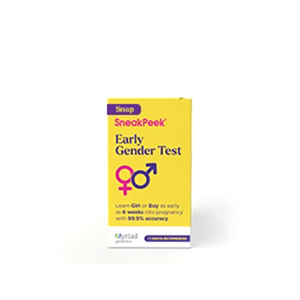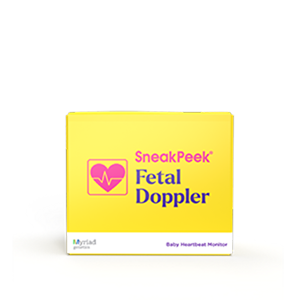Published on July 29th, 2022 and Updated on February 29th, 2024
Check out SneakPeek Baby Heart Monitor to hear your baby’s heartbeat earlier anytime, anywhere!
Pregnancy is an exciting and joyous journey…but it can also feel a little nerve-wracking. At times, you might wonder, Is my little one doing ok?
First, know that you’re not alone. Many moms-to-be want a better idea of what’s happening inside their wombs. That’s why one pregnancy tool has become quite popular—the fetal Doppler machine.
For decades, doctors have used fetal Dopplers to monitor a baby’s heartbeat during pregnancy. Recently, these devices have become available for home use, allowing expectant mothers to hear little heartbeats in their very own living rooms! However, many moms-to-be may wonder, is it safe to use a fetal doppler at home without a doctor?
Generally speaking, yes—as long as you understand how to properly use the fetal heart monitor and interpret its results. Let’s explore what lies at the heart of fetal Doppler machines.
What is a fetal Doppler?
Despite the somewhat intricate-sounding name, fetal Dopplers only have one job—to monitor your baby’s heartbeat via soundwaves.
Also known as fetal heart rate monitors, fetal Dopplers have advantages over old-school stethoscopes. Through sound waves, fetal Dopplers can:
- Detect the presence of a fetal heartbeat
- Give an exact fetal BPM (beats per minute)
- Show visible sonic wave patterns for heartbeats
- Share and record the sound of a fetus’s beating heart
Clinical Fetal Doppler Machines
At some point, your doctor will need to assess your baby’s heart health. To do this, they’ll use a clinical fetal Doppler machine.
During a fetal Doppler test, a doctor will check that the heartbeat falls in a healthy range (about 110 to 160 BPM). Medical professionals will test the fetal heartbeat during pregnancy and during labor. Here’s a breakdown of the timeline and purpose for each use:
During pregnancy – Usually, doctors will use a fetal Doppler at your second standard ultrasound (around 18 to 20 weeks) to evaluate the heartbeat for health. However, at this point in your pregnancy, you’ll likely have already heard your baby’s heartbeat at your initial ultrasound appointment, which takes place around 10 to 12 weeks. Although Doppler machines can be used before the second ultrasound (as early as 8 weeks), the results may be iffy. A baby’s heart may not be hearable with a Doppler machine early on in pregnancy due to a tilted uterus, the surrounding placenta or fat, or slow growth.
This whole segment above is incorrect. We use the fetal doppler at the 10-12 week first prenatal visit to confirm a fetal heart rate. First trimester ultrasounds are usually performed before this visit between 7-9 weeks.
During labor – Across your first and second labor stages, a Doppler will be used anywhere from every 5 to 30 minutes,or you may be continuously monitored with a fetal heart rate machine. This ensures that your baby’s little heart is fully pumping as he enters the world.
While fetal heart monitoring is useful for all moms, certain pregnancies require it more than others. Your doctor may use a fetal Doppler throughout the months of your pregnancy (as well as during labor) if you have certain high-risk pregnancy conditions that can also put fetal heart health at risk, such as:
- High blood pressure
- Diabetes
- Slow fetal growth
- Certain prenatal medications
At-Home Fetal Doppler Machines
Unlike most prenatal medical equipment, certain fetal Doppler machines are available “over-the-counter” for your own at-home use.
At-home fetal Dopplers (also called baby heart rate monitors or doptones) work the same as clinical fetal Dopplers. However, at-home machines don’t have the same sensitivity or power as clinical machines. That’s why manufacturers often suggest waiting until at least the second trimester before use—otherwise, you might interpret “no discernable heartbeat” as “no baby,” causing unnecessary distress.
Once you’ve reached the second trimester, an at-home fetal Doppler is an easy way to connect with your baby. In between doctor visits, you can detect and hear the little heart beating strong right from your very own couch.
How does a fetal Doppler work?
Whether clinical or at-home, a fetal Doppler machine is similar to an ultrasound machine in that it works through the use of sound waves. (However, unlike your standard ultrasound, a fetal Doppler does not produce an image of your baby).
The fetal Doppler is actually named after the Doppler effect, which explains how the echo of sound waves change based on their closeness to an object. By measuring this change, a fetal Doppler picks up the beats of your baby’s little heart.
Inside the machine and your belly, the process looks something like this:
- Wave emitting – All fetal Doppler machines have a probe or transducer. When placed on the belly, this small part of the machine emits quick pulses of ultrasound sound waves into the body.
- Wave reflection – Your baby’s little heart will “pick up” these sound waves, reflecting them back toward the machine. This echo action changes the frequency of the sound waves, making the start of an actual noise.
- Wave receival – When the echoed waves reach the Doppler machine, it converts them into a sound—and voila! A speaker or connected earphones can play you the thump-thump of a tiny heart. Some machines may also display the BPM.
Fetal Doppler Safety
In a doctor’s office, a fetal Doppler test will always be safe. Healthcare professionals are trained to use these machines correctly with very little risk. But is it safe to use a fetal Doppler at home by yourself?
In short, the answer is—probably. Just as long as you take the right precautions and care.
There is slight evidence that at-home fetal Doppler tests could be risky, due to their heating properties. If used incorrectly, the FDA warns a powerful ultrasound device may overheat the baby or create harmful cavitations (little bubbles) in surrounding body tissue. However, there is not a large body of evidence to back this up.
In reality, the main risk with at-home fetal Dopplers is from poor interpretation. Without proper understanding, moms-to-be can assume dangerous conclusions from:
- Using the device improperly and interpreting an inaccurate heartbeat
- Detecting a heartbeat and thinking the baby is healthy, despite contrary signs
- Detecting no heartbeat and thinking the baby is in danger
It’s also important to keep in mind that an at-home device is not a replacement for a clinical assessment. Even if using an at-home fetal Doppler, be sure to keep to the pregnancy checkup schedule recommended by your doctor. Make sure to schedule pregnancy checkups if you begin to feel any abnormal symptoms or feelings as well, such as a metallic taste in the mouth during pregnancy.
How to Use an At-Home Fetal Doppler
Ready to have a “heart-to-heart” with your little one?
Like breastfeeding or changing diapers, using a fetal Doppler has a learning stage. Luckily, our SneakPeek Fetal Doppler is easy to use and offers dependable detection at 16 weeks into pregnancy (although you may be able to detect your baby’s heartbeat as early as 12 weeks)!
Let’s go over the materials and steps you should know to be a pulse-detecting pro.
Materials
Most fetal Dopplers come in three connected parts—machine base, probe, and cord. Our version makes it easier and more portable by combining all parts into one convenient instrument. Whichever type you use, you’ll need a few other tools by your side:
- Ultrasound gel – When using any type of ultrasound machine, you need ultrasound gel. Otherwise, the sound waves won’t travel anywhere! A combination of water and propylene glycol, ultrasound gel conducts sound waves and reduces static output, thereby ensuring a successful heartbeat reading. The gel also lubricates and closes the space between your skin and the machine for a smoother, more comfortable experience.
- Machine batteries – Almost all at-home fetal Dopplers run on batteries, so it can be helpful to have backups on hand. The SneakPeek device comes with a standard 9V battery.
- Earphones – Our fetal Doppler offers an earphone jack for your own personal listening enjoyment. Otherwise, you can listen via speaker to hear your baby’s beautiful heartbeat.
- A seat – Sit back, relax, and spread the gel. Standing during a fetal Doppler test can result in poor readings for a couple of different reasons. For starters, being in a more comfortable position can help ensure you don’t rush the reading. Plus, when you sit in a reclined position, your uterus naturally tilts forward, making it easier for the device to detect your baby’s heartbeat.
Steps
Got your headphones? Good. Now, it’s time to feel the (heart)beat.
Give yourself plenty of time to complete your fetal Doppler test. After all, this is a special time to get a little closer to your precious baby. Once you’re relaxed and ready, start by following these step-by-step instructions for an accurate reading:
- Recline or lay down on your back in a comfy position.
- Switch on your fetal Doppler machine and connect any headphones you may use.
- Expose your stomach, clearing all clothing from the area.
- Spread ultrasound gel in an even and thick layer across your lower stomach.
- Place the device on the gelled area, slowly and gently moving it from bottom -to -top.
- Slowly move the device, changing angles until you can detect a beat.
- Enjoy the beautiful sounds of your little one’s heart fluttering!
- Turn off and wipe down the device when done and remove any excess gel from your stomach.
Finally, remember—using a fetal Doppler takes practice. If you can’t detect your baby’s heartbeat at first, give it a few more tries. With our device, the best results start at 16 weeks (although you can try using the device as early as 12 weeks). With a little time and practice, you’re sure to have the heartful moment you’ve been waiting for.
Open Your Heart with SneakPeek
Listening to the heartbeat of your precious baby can be a life-changing experience. With proper use, the SneakPeek At-Home Fetal Doppler can let you experience this from the comfort of your home and connect with your baby in an exciting new way before she’s born.
Can’t wait to learn even more about your baby? Let us offer another window into the future—the SneakPeek Test for gender prediction!
With one easy kit, our Gender Blood Test can predict fetal sex as early as 6 weeks (that’s months ahead of your 18 to 20-week anatomy scan ultrasound), as well as signs of a twin pregnancy. In fact, we’re the only test that offers results that early and with over 99% clinically-proven accuracy1, privacy-protected results, and a 100% money-back guarantee. If you’re wondering how much a gender blood test is with insurance, educate yourself on the topic to make sure that buying one is the best move for you.
Trusted by over 1 million moms and rated #1 by OB-GYN professionals, we’re a cut (or rather, a beat) above the rest. Try our gender blood test, then our at-home fetal Doppler, and let us help your love shine.
This post has been reviewed for accuracy by the following medical professional:
Dr. Heather Soper, Certified Nurse Midwife
Dr. Heather Soper brings over 15 years of experience in women's health and obstetrics to her role as the owner of The Genesis Resort for Birth. Complementing her clinical practice, she serves as an Assistant Professor of Nursing at James Madison University, where she educates nursing students with a focus on compassionate, patient-centered care. Her advanced training and dedication to midwifery are evident in her contribution to both academia and the wellness of expectant mothers
Sources:
- Cincinnati Children’s Hospital. Ultrasound Gel: A Necessary Mess – Cincinnati Children’s Blog. https://blog.cincinnatichildrens.org/radiology/ultrasound-gel-a-necessary-mess
- FDA. Avoid Fetal “Keepsake” Images, Heartbeat Monitors. https://www.fda.gov/consumers/consumer-updates/avoid-fetal-keepsake-images-heartbeat-monitors
- John Hopkins Medicine. Fetal Heart Monitoring. https://www.hopkinsmedicine.org/health/treatment-tests-and-therapies/fetal-heart-monitoring
- Medline Plus. Doppler Ultrasound: MedlinePlus Medical Test. https://medlineplus.gov/lab-tests/doppler-ultrasound/
- Northwell Health. Weekly appointments – Obstetrics. https://www.northwell.edu/obstetrics-and-gynecology/obstetrics/what-to-expect/weekly-appointments
- Pertanika Journal of Science and Technology. A review of the thermal effects during pregnancy by using ultrasound: Doppler mode. https://www.researchgate.net/publication/332250615_A_review_of_the_thermal_effects_during_pregnancy_by_using_ultrasound_Doppler_mode
- PLOS ONE. Intermittent auscultation fetal monitoring during labour: A systematic scoping review to identify methods, effects, and accuracy. https://journals.plos.org/plosone/article?id=10.1371/journal.pone.0219573
- Stanford Children’s Hospital. Fetal Heart Monitoring. https://www.stanfordchildrens.org/en/topic/default?id=external-and-internal-heart-rate-monitoring-of-the-fetus-92-P07776
- Verywell Family. When Can You Hear Your Baby’s Heartbeat on a Doppler? https://www.verywellfamily.com/when-can-you-hear-the-babys-heartbeat-on-a-doppler-2371532
- Verywell Family. Fetal Doppler: When It Is Used, How It Works, Safety. https://www.verywellhealth.com/fetal-doppler-5119457

Shop Our Products
SneakPeek aims to provide the most accurate and up-to-date information to help our readers make informed decisions regarding their health before, during, and after pregnancy. This article was written based upon trusted scientific research studies and/or articles. Credible information sources for this article are cited and hyperlinked.






